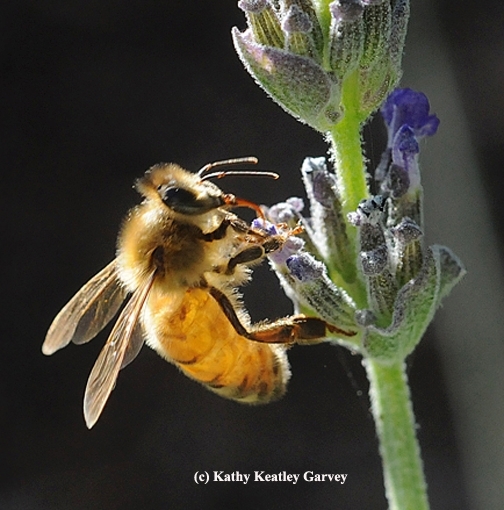
The scene: A honeybee (Apis mellifera) and a bumblebee (Bombus vosnesenskii) nectaring on a purple coneflower (Echinacea purpurea) in a UC Davis bee garden.
If you've observed honeybees and wild bees foraging in your garden, you've probably wanted to compare them. Is the honey bee the most effective pollinator?
Newly published UC Davis research in the American Journal of Botany yields some surprising results.
Honeybees are effective pollinators, but when compared to other pollinators, including wild bees, they are rarely the most effective plant pollinators, according to a meta-analysis project led by doctoral candidate Maureen Page and postdoctoral researcher Charlie Casey Nicholson of the Neal Williams laboratory, UC Davis Department of Entomology and Nematology.
Page and Nicholson are the co-leading authors of "A Meta-Analysis of Single Visit Pollination Effectiveness Comparing Honeybees and other Floral Visitors," the cover story of the current edition of the journal, published Nov. 30.
“Although high visitation frequencies make honeybees important pollinators, they were rarely the most effective pollinators of plants and were less effective than the average bee,” said Page. “This suggests that honeybees may be imperfect substitutes for the loss of wild pollinators and ensuring pollination will benefit from conservation of non-honeybee taxa. In the future, we hope other researchers will use the data we have collected to further investigate the factors that influence pollination effectiveness.
Page and Nicholson originated the idea for the project during a graduate seminar led by UC Davis professor and community ecologist Louie Yang in the winter of 2020. While the COVID-19 pandemic shut down or postponed many other research projects, Page and Nicholson forged ahead and organized fellow graduate students and postdoctoral students to collectively read and extract single visit-effectiveness data from more than 468 papers. The two then analyzed the data from a subset of these papers (168) to ask whether honeybees and other floral visitors differed in their single visit pollination effectiveness.
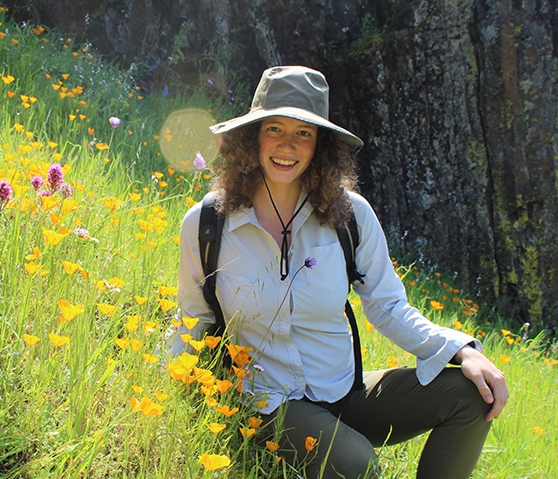
The researchers conducted a hierarchical meta-analysis of 168 studies and extracted 1564 single visit effectiveness (SVE) measures for 240 plant species. “We paired SVE data with visitation frequency data for 69 of these studies,” they wrote. “We used these data to ask three questions: (1) Do honeybees (Apis mellifera) and other floral visitors differ in their SVE? (2) To what extent do plant and pollinator attributes predict differences in SVE between honeybees and other visitors? (3) Is there a correlation between visitation frequency and SVE?”
They compared honeybees to multiple pollinator groups, including ants, bees, beetles, birds, butterflies, flies, moths, and wasps.
"Surprisingly, honeybees were less effective than other bees as pollinators of crop plants, suggesting that the importance of honeybees as crop pollinators derives largely from their numerical abundance rather than the quality of their floral visits," Page said.
“Honeybees were significantly less effective than the most effective non-honeybee pollinators but were as effective as the average pollinator," they wrote in their results section of the paper. "The type of pollinator moderated these effects. Honeybees were less effective compared to the most effective and average bird and bee pollinators but were as effective as other taxa. Visitation frequency and SVE were positively correlated, but this trend was largely driven by data from communities where honeybees were absent.”
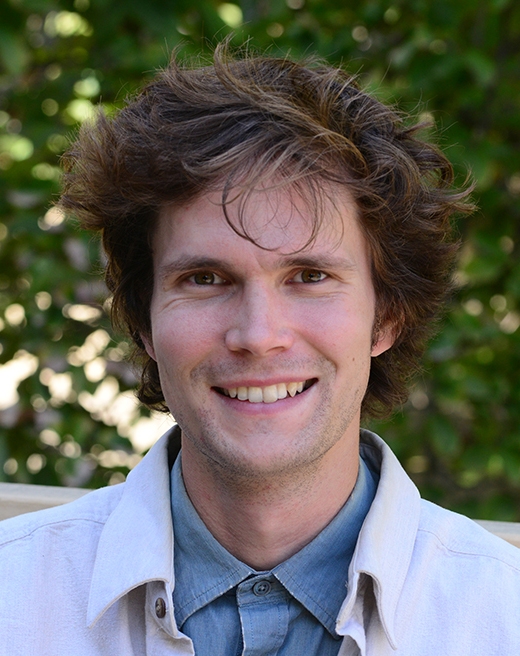
Also contributing to the project were Ross Brennan, Anna Britzman, Jessica Greer, Jeremy Hemberger, Hanna Kahl, Uta Müller, Youhong Peng, Nick Rosenberger, Clara Stuligross, Li Wang, and Professors Louie Yang and Neal Williams.
Cover Photo. The cover photo, by Kathy Keatley Garvey, communications specialist, UC Davis Department of Entomology and Nematology, shows several species of bees on a sunflower, Helianthus sp. They include a honeybee (Apis mellifera), sunflower bee (Svastra obliqua), and two sweat bees (Halictus tripartitus and Halictus ligatus), as identified by Professor Williams, a pollinator ecologist.
"Honeybees are as effective as the average pollinator, but rarely the most effective pollinators of plants," according to the caption. "Surprisingly, honeybees are less effective than other bees as pollinators of cultivated plants, suggesting the importance of honeybees as agricultural pollinators derives largely from their numerical abundance. Their study confirms a widely held belief that honeybees are not the best pollinators of plants globally and substantiates the growing concern that honeybees may be imperfect substitutes for the loss of wild pollinators."
Charlie Nicholson. Nicholson, a researcher in the UC Davis Department of Entomology and Nematology labs of both Professor Neal Williams, and Extension apiculturist Elina Lastro Niño, holds a bachelor of arts degree in biology (evolution, ecology and behavior), 2010, cum laude, from Skidmore College, Saratoga Springs, New York. He received his doctorate in natural resources in 2018 from the University of Vermont, where he was a Gund Institute for Environment graduate fellow. In his dissertation, he examined how landscape and farm management affect the multiple benefits provided by wild bees.
Nicholson joined UC Davis as a postdoctoral scholar in the spring of 2019, and receives funding support from the USDA Invasive Species and Pollinator Health Unit. He recently co-authored a paper, “Natural Hazard Threats to Pollinators and Pollination,” published in the journal Global Change Biology, that analyzed 117 published research papers on natural hazards that threaten pollinators and pollination.
Maureen Page. Page received her bachelor's degree in biology, cum laude, from Scripps College, Claremont, Calif., in 2016, and then enrolled in the UC Davis entomology graduate program, with a career goal of becoming a professor and principal investigator. In 2018, she received prestigious three-year fellowship, a National Defense Science and Engineering Graduate Fellowship, for her research proposal, “Promoting Food Security by Optimizing Wildflower Plantings to Support Wild and Managed Bees." Long interested in bee research, Page received a 2013 Scripps Environmental Research Grant to establish a solitary bee monitoring program at the Bernard Field Station in Claremont. She created a reference collection and species list of bee diversity at the field station, gaining experience collecting, pinning and identifying bee specimens. She presented her findings at the Scripps Undergraduate Research Symposium. Page later worked on a project categorizing pollen deposition by the yellow-faced bumble bee, Bombus vosnesenkii to California figwort, Scrophularia california.
Attached Images:
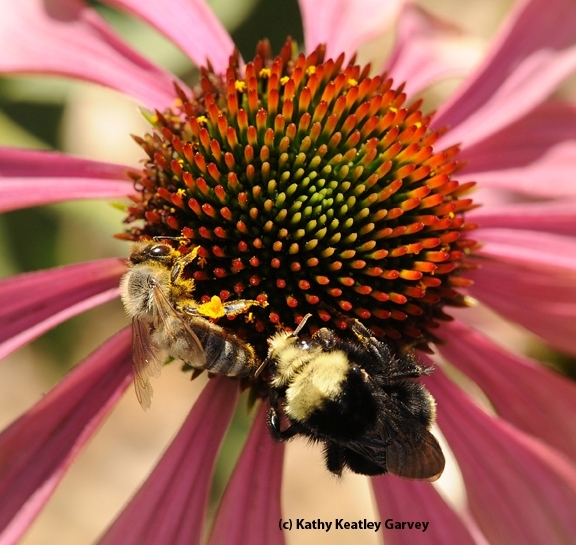
A honeybee (Apis mellifera) and a bumblebee (Bombus vosnesenskii) nectaring on a purple coneflower (Echinacea purpurea) in a UC Davis bee garden. (Photo by Kathy Keatley Garvey)
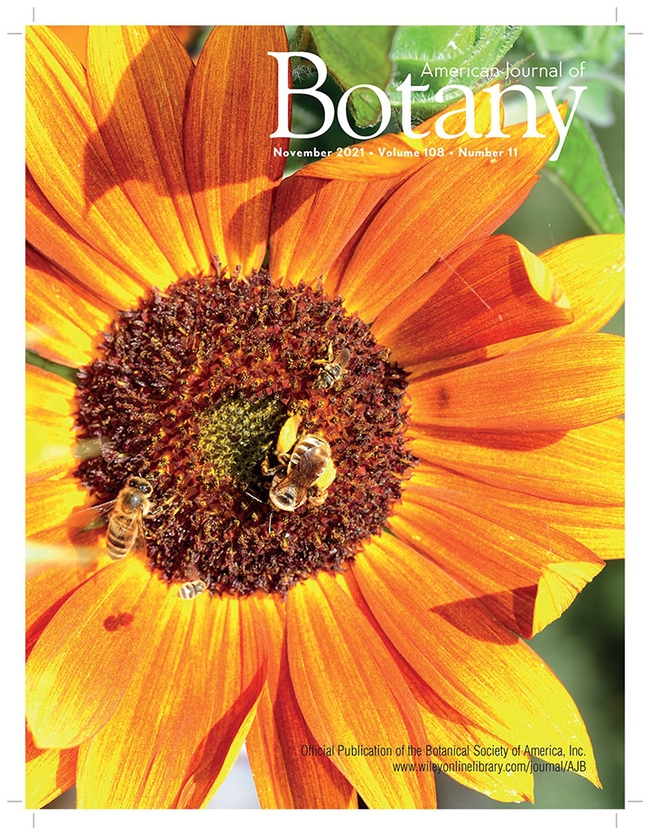
This is the cover of the American Journal of Botany, featuring several species of bees on a sunflower, Helianthus sp, (Cover photo by Kathy Keatley Garvey)